Tadano GT-550E-2 Service Manual

2SHUDWLRQ DQG 0DLQWHQDQFH 0DQXDO
͑
͑
͑
͑
7UXFN &UDQH
0RGHO *7 (
$SSOLFDEOH 6HULDO 1R *7
͑
͑
%4 7$'$12 /7'
͑
 &$87,21 5HDG WKLV PDQXDO EHIRUH RSHUDW
&$87,21 5HDG WKLV PDQXDO EHIRUH RSHUDW
6DYH WKLV PDQXDO IRU IXWXUH UHIH
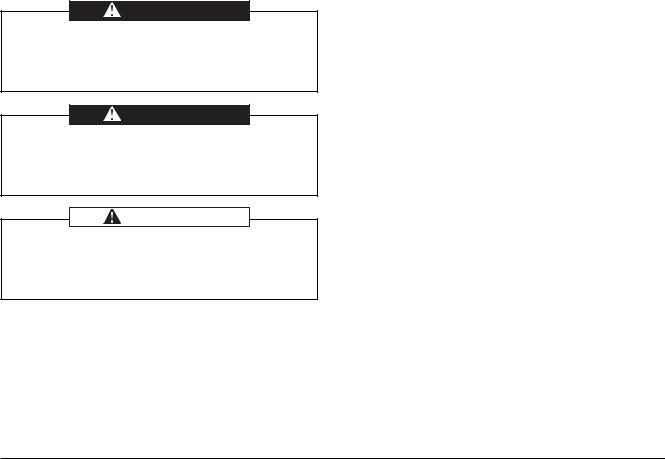
T002423E
Safety
Most accidents that occur during crane operation and maintenance are caused by failure to observe basic safety rules and precautions. Before operating your machine or performing maintenance, read and become familiar with all the safety precautions and recommendations given in this section. Remember that failure to observe even a single precaution could involve you and the people around the machine in a serious accident.
Foreseeing potential dangers is vital for preventing accidents. All personnel working with the machine, including the supervisor, crane operator and oiler, should be sensitive to potentially dangerous situations and take the necessary measures to prevent accidents.
Safety precautions and recommendations are outlined in this section and are also included in the operation and maintenance instructions given in subsequent sections. Warning labels are also provided on the machine.
The cautionary instructions in this manual are identified as “DANGER”, “WARNING”, “CAUTION” or “NOTICE”. These terms are defined as follows:
DANGER
 DANGER indicates an imminently hazardous situation, which, if not avoided, would result in death or serious injury.
DANGER indicates an imminently hazardous situation, which, if not avoided, would result in death or serious injury.
WARNING
 WARNING indicates a potentially hazardous situation, which, if not avoided, could result in death or serious injury.
WARNING indicates a potentially hazardous situation, which, if not avoided, could result in death or serious injury.
CAUTION
 CAUTION indicates a potentially hazardous situation, which, if not avoided, may result in a minor or moderate injury.
CAUTION indicates a potentially hazardous situation, which, if not avoided, may result in a minor or moderate injury.
[NOTICE]
NOTICE indicates an important operational or maintenance procedure or condition, which, if not strictly observed, can result in damage to machine components or deteriorated machine performance.
It is virtually impossible to anticipate every situation that might present a hazard. The safety precautions given in this manual and on the machine labels are not exhaustive.
It is important, therefore, to strictly follow the instructions in this manual and be sensitive to potential dangers in order to prevent bodily injury and damage to the machine.
Remember that your most important duty is to ensure the safety of you, your co-workers and any other people in the area.
Safety |
A-1 |
Safety |
|
|
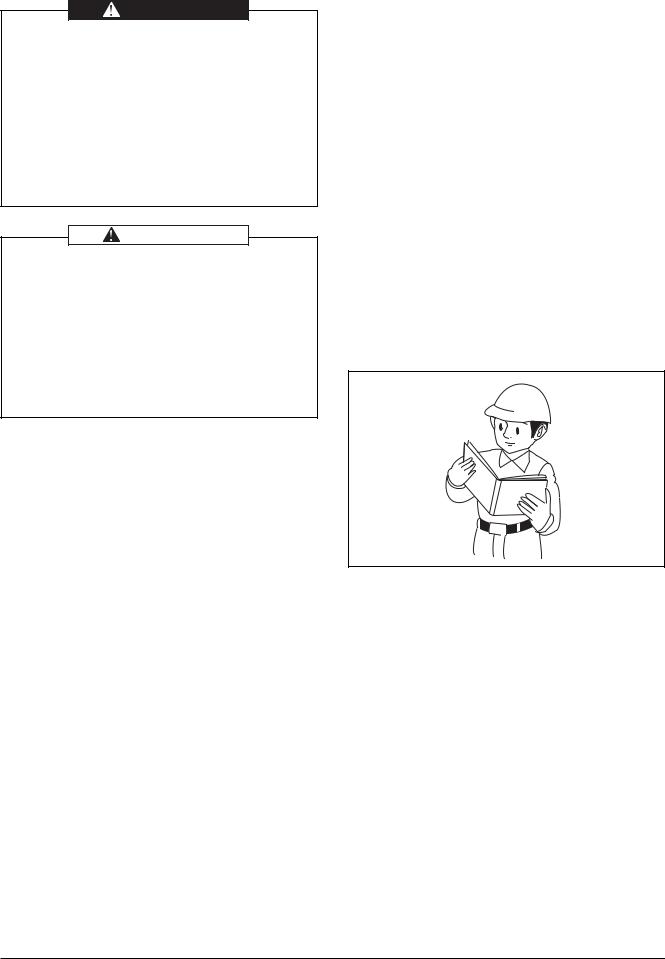
Safety Rules
WARNING
 Use of improper or unauthorized method during operation or maintenance of this machine can be dangerous and could lead to serious injury or death. Read this manual thoroughly and be familiar with the proper operating and maintenance procedures before using the machine. Do not operate the machine or perform maintenance on it until you understand the instructions in this manual.
Use of improper or unauthorized method during operation or maintenance of this machine can be dangerous and could lead to serious injury or death. Read this manual thoroughly and be familiar with the proper operating and maintenance procedures before using the machine. Do not operate the machine or perform maintenance on it until you understand the instructions in this manual.
CAUTION
 “Safety Rules” section describes the general instructions about operation with a hydraulic truck crane. For more detailed instructions about your machine, see corresponding pages (white pages) of this manual.
“Safety Rules” section describes the general instructions about operation with a hydraulic truck crane. For more detailed instructions about your machine, see corresponding pages (white pages) of this manual.
The figures in this manual are for reference showing the important points. They may be different from an actual machine.
Before Operation A-2
Rules for Operation (Setting Outriggers) A-7
Rules for Operation (General) A-8
Rules for Operation (Weather) A-17
Rules for Operation (Power Lines, Radio Waves) A-18
Rules for Operation (Special Operation) A-20
After Operation A-20
Rules for Road Travel A-21
Rules for Inspection and Maintenance A-22
T019605E
Before Operation
 Qualifications of the Operator
Qualifications of the Operator
The operator must be fully trained and qualified. The operator must be fully familiar with on-site safety rules, and national and local crane operation regulations.
 Study the Operation and Maintenance
Study the Operation and Maintenance
Manual
Improper operation, inspection or maintenance can damage the machine or cause injury or death. Study the manual carefully. Become familiar with the proper procedures for operation, inspection and maintenance.
Keep the Operation and Maintenance Manual in the crane operator’s cab so that it is always readily accessible.
Operation |
|
|
Manual |
||
|
T20001
 Follow All Instructions and Warnings
Follow All Instructions and Warnings
The Operation and Maintenance Manual and the warning labels on the machine contain instructions and must be followed to ensure safe operation. Read and understand all DANGER, WARNING and CAUTION labels. Neglecting these instructions and warnings can result in injury or death.
If the manual is lost or any labels (decals) become illegible, order replacements from the nearest authorized TADANO distributor or dealer.
Safety Rules |
A-2 |
Safety Rules |
|
|
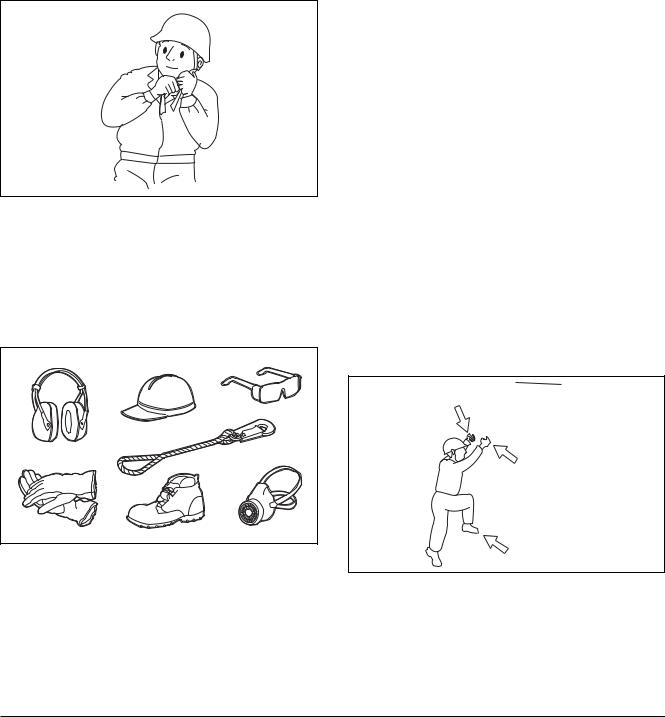
 Always Maintain Labels
Always Maintain Labels
The warning labels on various parts of the machine provide important instructions for safe operation. Always keep the labels (decals) clean and visible. Should labels become lost or damaged, order replacements from the nearest authorized TADANO distributor or dealer.
T019605E
 Avoid Overwork. Never Operate under the Influence of Alcohol or Drugs
Avoid Overwork. Never Operate under the Influence of Alcohol or Drugs
If the operator is tired, lacking in sleep, or under the influence of medication or alcohol, the probability of an accident event is greatly increased since attentiveness and judgment are impaired. Maintain proper physical fitness for crane operation.
 Wear Proper Clothing
Wear Proper Clothing
Sloppy clothing may result in sleeves or cuffs being caught and then cause an accident.
T20002
 Wear Approved Protective Gear
Wear Approved Protective Gear
To ensure safety, always wear a hard hat and safety shoes. Also protective goggles, dust mask, earplugs, work gloves, safety belt, etc. must be worn as the situation requires. Check that all protective gear is in good condition before wearing it.
T00041
 Keep All Footings and Shoes Clean
Keep All Footings and Shoes Clean
Oil, water or mud on soles of shoes, steps or decks can cause slip off and fall mishaps or cause accidental release of a control pedal. Always remove oil, mud, water or snow before operation and keep shoes and floor of the operator’s cab clean.
Do not leave any parts or tools on the operator’s cab floor or passageway.
 Safely Climbing onto and Descending from the Machine
Safely Climbing onto and Descending from the Machine
Do not jump onto or off the machine.
Do not climb onto or descend from the machine with objects in hand.
Only climb onto or descend from the machine while it is completely at standstill. Use the handrails and steps, always support your hands and feet firmly (three point support); that is, one hand-two feet or two hands-one foot.
Never use the steering wheel or control levers as handrails.
T03833 |
Safety Rules |
A-3 |
Safety Rules |
|
|
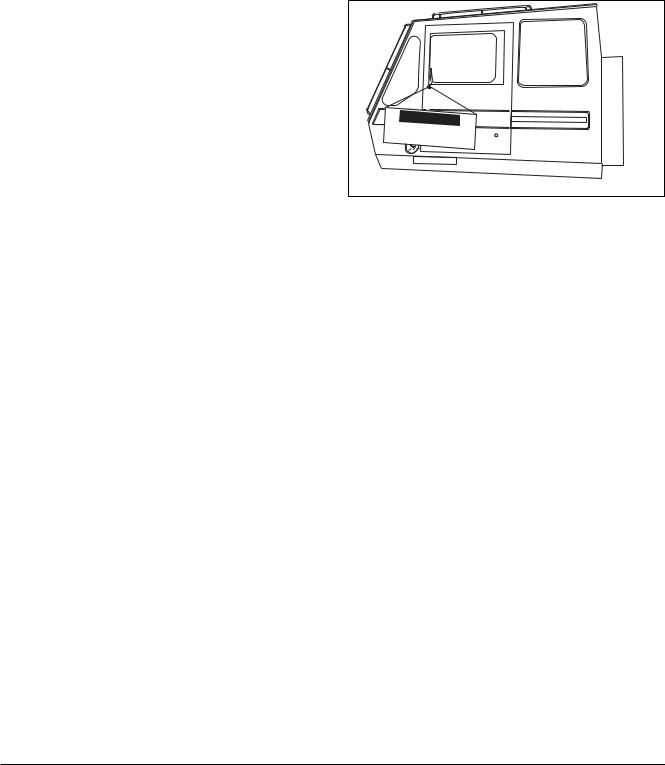
 Correctly Position the Seat
Correctly Position the Seat
Incorrect positioning of the operator’s seat can result in mistakes or fatigue, possibly leading to an accident.
Before operating the machine, correctly position the seat so that the pedals and levers can be manipulated correctly.
 Maintain Good Visibility
Maintain Good Visibility
Fouled window panels, lights or rearview mirrors can limit the operator’s visibility, impairing safe operation. Always keep the window panels and light lenses clean.
Position mirrors correctly as required by job conditions.
 Perform Pre-Operation Inspection
Perform Pre-Operation Inspection
Neglecting routine inspections and maintenance can shorten service life of the machine or even result in an accident.
Before starting operation (and before taking over a shift), perform the pre-operation inspection on the carrier and the upper structure to ensure that the machine is in proper condition and free from any problems.
Should any problem be found, report it to the responsible person, remedy it, and only then start operation.
T019605E
 Do Not Operate a Machine Being Inspected or Serviced
Do Not Operate a Machine Being Inspected or Serviced
Operating the machine while it is undergoing inspection or maintenance work can cause damage or an accident.
Post a “DO NOT OPERATE” sign on the operator’s cab door or any control lever. Do not attempt to operate the machine until the sign is removed by maintenance personnel.
WARNING |
DO |
NOT OPERATE |
T01938E |
 Check the Position of Controls before Starting the Engine
Check the Position of Controls before Starting the Engine
If any control lever is in a position other than “neutral”, the machine may initiate some mechanical or hydraulic function as soon as the engine is turned over. This situation is very dangerous. Start the engine only when completely sure that all controls are in the proper neutral or inactive position.
 Make Sure Work Area Is Safe before Starting the Engine
Make Sure Work Area Is Safe before Starting the Engine
Starting the engine without performing a thorough safety check of the work area may cause damage to the machine or injury or death.
Make sure there are no personnel or obstacles underneath or around the machine.
Before starting the engine, sound the horn to warn any nearby personnel.
Safety Rules |
A-4 |
Safety Rules |
|
|

 Start the Engine from the Operator’s Cab Only
Start the Engine from the Operator’s Cab Only
If the engine is started from any location other than the crane operator’s cab, it can become impossible to avoid a dangerous hazard if some machine action is initiated when the engine turns over.
Start the engine only from the operator’s seat.
 Inspection after Starting the Engine
Inspection after Starting the Engine
Failure to perform a basic inspection after starting the engine can result in not detecting fault or abnormality with the machine.
Inspect the machine in a safe location that is free from obstacles and people other than maintenance personnel.
Allow the engine to warm up after it is started while the instrument readings and checking the machine components. Once the engine is properly warmed up, make a safety check of the work area, and run the machine without a load to check out condition of the controls, machine elements and safety devices.
 Warm Up the Machine
Warm Up the Machine
Failure to properly warm-up the engine and various other machine components can result in decrease in service life of the machine or malfunctions. In winter, run the engine for at least five minutes for proper warm-up.
Then, run the engine at low speed without a load to warm up the hydraulic oil and other machine components.
T019605E
 Night Operation
Night Operation
Operation in the dark makes it difficult to ensure good footing, and to locate nearby persons or obstacles, increasing the probability of an accident. When operating at night, turn on all working lamps. Provide ancillary portable lighting equipment to illuminate the work area.
T00020 |
 Keep the Engine Clean
Keep the Engine Clean
Dead leaves, paper dust and oil stains on and around the engine can catch fire. Remove all such debris before commencing operation.
 Keep Unauthorized Personnel Away from the Work Area
Keep Unauthorized Personnel Away from the Work Area
Unauthorized personnel or vehicles in the work area can result in collision accidents, injury or death. Before operation, make sure there are no unauthorized personnel or obstacles within the work area. If the work area is situated near heavy traffic, post a control person to prevent vehicular accidents. Barricade the work area with appropriate means either colored tape or rope.
DANGER |
STAY CLEAR |
T01937E |
Safety Rules |
A-5 |
Safety Rules |
|
|
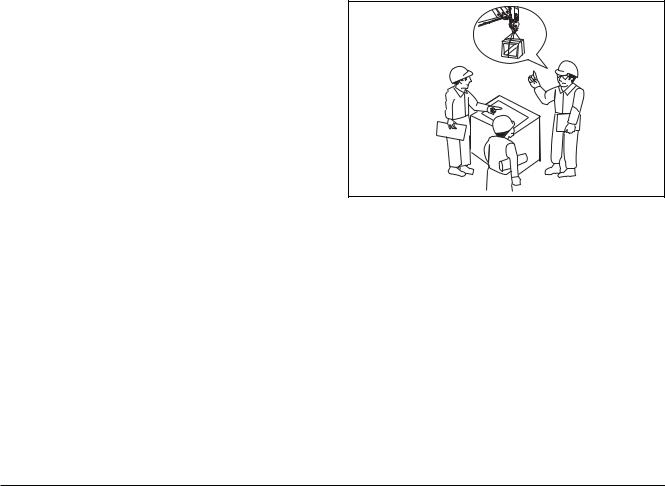
T019605E
 Anticipate Accident Situations
Anticipate Accident Situations
To deal with possible accidents or fires, equip the crane with a first-aid kit and fire extinguisher. Be aware of the locations of these safety items, and learn how to use them properly.
An emergency contact person and emergency liaison plan should be carefully prepared, and all personnel concerned must be made aware of the details.
 Observe Work-site Rules
Observe Work-site Rules
Neglecting work-site rules can result in accidents. To ensure safe operation, observe all work-site rules covering prohibited practices, precautions and correct procedures.
 Post a Signal Person
Post a Signal Person
Assign a signal person for all crane operations as necessary and always follow instructions especially when:
•Working near power lines.
•The load is hidden from the crane operator’s view.
•Moving the carrier along narrow roads or when the operator’s vision is obscured.
The signal person and the operator should communicate with each other using mobile transceiver phones.
 Hold Work Site Meetings with Concerned All Personnel
Hold Work Site Meetings with Concerned All Personnel
Lack of sufficient communications with concerned personnel can result in accidents.
Before starting the job, set up a liaison meeting with the site supervisor, rigging personnel, signal person, etc., to agree on the following details:
•Mass of load, lifting height (per rated lifting capacity table), locations of loading and unloading, work area of the machine, craning procedures, rigging methods, etc.
•Conditions of ground where crane is set as well as whether city-water and gas pipings are buried.
•Overturning prevention by use of block plates and outriggers.
•Mutually agreed upon and OSHA approved signal conventions between rigging personnel and signal person.
•Designation of off-limit areas, provision of barricade.
•Work stations of all relevant workers.
•Emergency liaison plan and emergency contact person, as well as the safety/health organization.
T20004
Safety Rules |
A-6 |
Safety Rules |
|
|
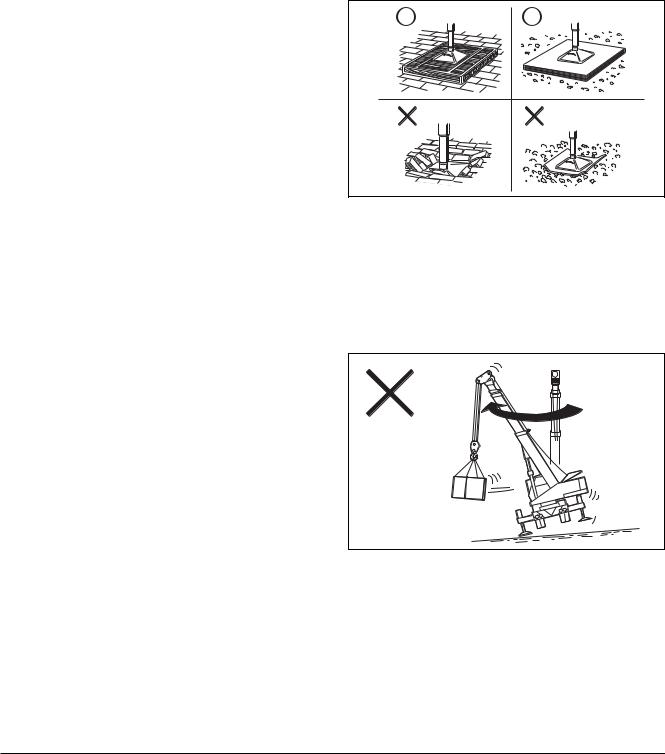
T019605E
 Always Study Work-site Conditions
Always Study Work-site Conditions
Carefully
Pay due attention to surrounding conditions. Before starting the job, inspect the work area, check routes to the work area, and monitor the presence of any obstacles and locations of other machinery. Note changes in the surroundings or site conditions as crane operations are carried out.
 Multi-Crane Operation
Multi-Crane Operation
In lift situations involving the coordination of two or more cranes, establish an agreed system for communications and assign a signal person. The crane operators must proceed cautiously, strictly observing all instructions of the signal person.
Rules for Operation
(Setting Outriggers)
 Set the Crane on Firm Level Ground
Set the Crane on Firm Level Ground
The machine should not be located on soft ground, which can lead to sinking, sliding or overturning, nor on the edge of a pit, bank or slope.
If the ground conditions are doubtful, use blocks or steel plates of sufficient strength and size below the outrigger floats to disperse the load.
T20617 |
 Set the Crane Level
Set the Crane Level
If the crane is tilted, and the load is swung over the side, the load radius will increase, and the machine can overturn.
When setting the outriggers, level the machine carefully using a level.
T00008
Safety Rules |
A-7 |
Safety Rules |
|
|
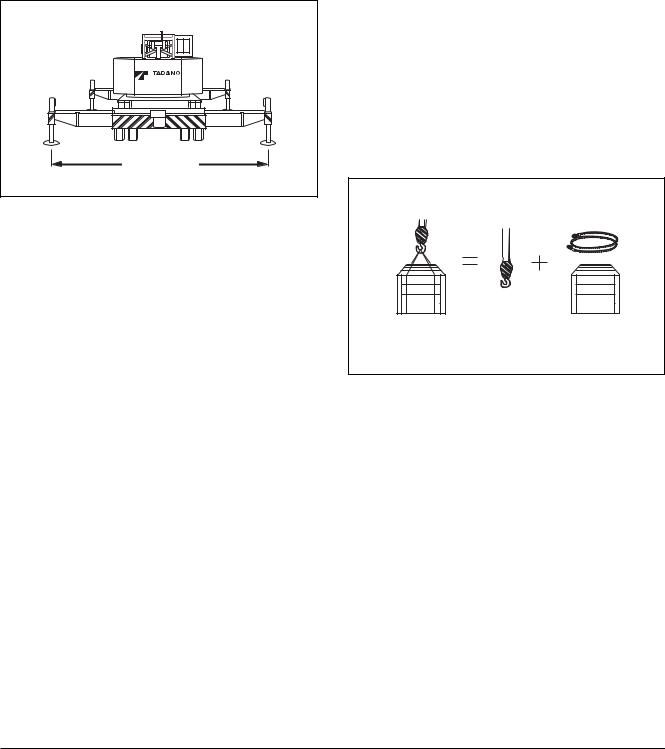
T019605E
 Fully Extend the Outriggers
Fully Extend the Outriggers
If the outriggers are not extended correctly, the crane may become unstable, causing the crane to overturn.
As a general rule, always extend the outriggers fully, even if the crane is rated for operation with the outriggers at middle or minimum extension. If it is absolutely necessary to use the outriggers at middle or minimum extension, make sure the machine is within the rated limits.
Fully extended
T01939E
 Check the Outrigger Setting
Check the Outrigger Setting
Incorrect setting of the outriggers can decrease the load lifting capacity of the machine and result in overturning. To avoid crane instability, make sure:
•The machine is absolutely level.
•All outrigger floats are stable and set firmly on the ground or blocks.
•All tires are clear of the ground.
•The outriggers are secured with lock pins (if lock pins are available).
Rules for Operation (General)
 Observe Working Conditions
Observe Working Conditions
Operating the crane under conditions (outrigger beam length, boom length, load radius, etc.) other than specified in the rated lifting capacity table can cause overturn even when not lifting a load. Follow all instructions in the rated lifting capacity table.
 Do not Exceed Rated Lifting Capacity
Do not Exceed Rated Lifting Capacity
Exceeding the rated lifting capacity will overload the machine. Damage or overturning can result from this practice.
Check the rated lifting capacity table before operating to ensure that the lift is safe. Load lifting capacity of the crane varies depending on boom length and load radius. Never exceed the lifting capacity in the table.
Mass of hook block
Rated lifting capacity |
Lifting capacity |
T21566E
 Use Safety Devices Correctly
Use Safety Devices Correctly
Improper use of safety devices including the overload cutout can lead to damage or overturn the crane.
Use all safety devices according to instructions in the manual.
Safety Rules |
A-8 |
Safety Rules |
|
|

T019605E
 Do Not Rely Exclusively on Safety Devices
Do Not Rely Exclusively on Safety Devices
A safety device is not a substitute for human skill and judgment.
The overload cutout, for example, does not warn the operator about conditions on the ground, effects of wind, improperly adjusted devices, load being pulled sideways, or other possibly hazardous situations.
All safety devices are merely auxiliary means to help the operator perform the task at hand. Safe crane work requires the qualities of a good operator, such as skill, experience, judgment, and safety awareness.
 Do Not Deactivate Any Safety Devices
Do Not Deactivate Any Safety Devices
Avoid any action that impairs normal operation of the safety devices.
Intentionally deactivating any safety device may result in the inability to detect overloading or overwinding during operation, and lead to a serious accident.
Ensure that all safety devices are functioning correctly before starting any operation.
 Rig the Load Securely
Rig the Load Securely
Improper rigging procedure can result in the lifted load being dropped. Rig the load securely, paying special attention to the following points:
•Know the mass, shape and center of gravity of the load, and use suitable load handling devices and rigging hardware.
•The load handling devices including wire ropes, chains and rigging hardware must have enough strength and be free from damage or excessive wear.
•Rig the load so that it is suspended at a point above its center of gravity. Otherwise, the load can overturn or come loose of the handling device when it is raised. Also, wire ropes and chains must not be crossed or twisted around each other.
•Do not rig the load with a single wire rope. Such rigging practice is very dangerous as the load can rotate, and untwist the wire rope, reducing its strength.
•When rigging a load with sharp corners, fit protective softeners at the load corners to protect the wire ropes and the load itself against damage.
 Before Lifting a Load
Before Lifting a Load
Make sure of the following before attempting to pick up a load:
•The mass does not exceed the rated lifting capacity.
•The number of rope parts conforms to the standard in the rated lifting capacity table.
•A proper load handling device is used and the load is securely rigged.
•The hook block is located directly above the center of gravity of the load.
•The wire ropes runs are plumb so that the load can be lifted vertically.
•The safety latch on the hook is working properly.
•The wire rope has no entanglement or disorderly winding on the drum.
 Consider Boom Deflection before Lifting the Load
Consider Boom Deflection before Lifting the Load
When a load is lifted, the boom will deflect downward, increasing the load radius. Swaying of the load also poses a hazard to the people around the crane, and may lead to overloading.
If the load starts to sway when lifted clear of the ground, lower the load back on the ground. When lifting a heavy load or using the extended
boom, anticipate the possible increase in the boom load radius.
Boom deflects |
Load radius |
T03802E |
Safety Rules |
A-9 |
Safety Rules |
|
|
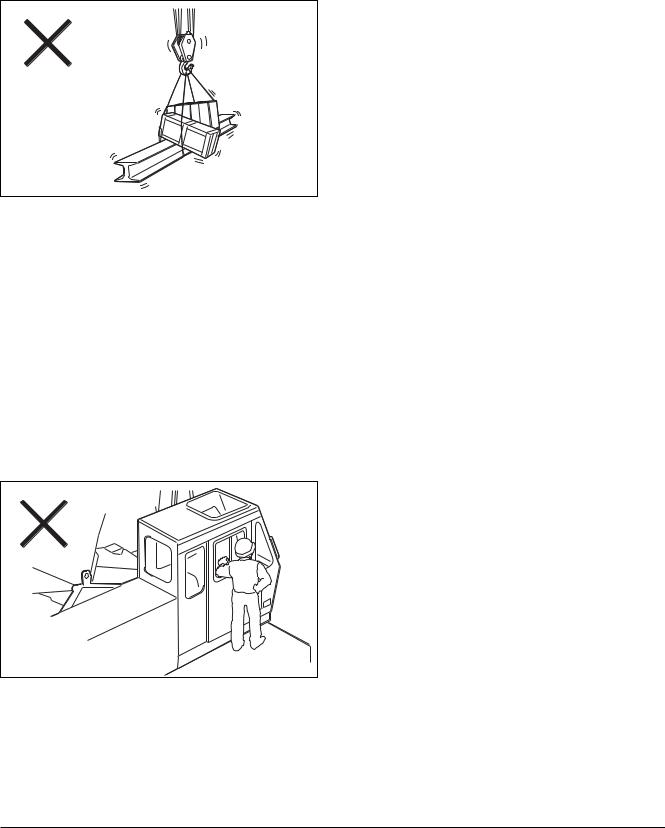
T019605E
 Lift Single Loads Only
Lift Single Loads Only
Do not lift two or more loads simultaneously even if their total mass is within the specified rated lifting capacity; otherwise, the loads may lose balance. It is usually not possible to maintain complete attention to multiple loads.
T00011
 Operate According to Signals
Operate According to Signals
If signals are not obeyed or if signals are improperly made, accidents can occur.
Follow instructions of the signal person. An emergency shut down signal must be acknowledged whoever gives it.
 Operate the Crane from the Operator’s Cab Only
Operate the Crane from the Operator’s Cab Only
Controlling the machine from outside the cab, through the cab window, is strictly forbidden and extremely dangerous.
T00019 |
 Conduct a Safety Check within the Load Radius of the Crane before Starting Operation
Conduct a Safety Check within the Load Radius of the Crane before Starting Operation
Any person located close to the crane may become caught between machine components or between the counterweight and a fixed obstacle. Before starting any swing motion, make sure that there is no one nearby. Sound the horn to warn all immediate personnel of crane startup.
During crane operations, fence off or barricade the work area to prevent unauthorized persons from approaching the machine.
 Be Extremely Careful When Raising the Load Clear of the Ground
Be Extremely Careful When Raising the Load Clear of the Ground
Stop lifting the load once the rigging is fully taut, check that the load is suspended at a point just above its center of gravity, and that the load is not stuck to the ground or interfering with a nearby body or structure.
Lift the load vertically. When the load clears the ground, stop lifting and suppress any swaying; then check that the rigging is secure, the load is in a stable position, and the crane is not overloaded.
Then, recommence the lift again.
 Do Not Lift the Load Clear of the Ground by Raising or Extending the Boom
Do Not Lift the Load Clear of the Ground by Raising or Extending the Boom
Raise a load clear of the ground by vertical hoisting only.
Raising or extending the boom to lift a load clear of the ground will cause the load to sway, posing a hazard.
If the boom is elevated to raise a load clear of the ground, the crane will not be automatically stopped even in case of an overload. An overloaded machine can overturn or be damaged.
Safety Rules |
A-10 |
Safety Rules |
|
|

 Move a Lifted Load Carefully
Move a Lifted Load Carefully
When the crane state comes near the full rating, the AML gives an intermittent alarm. Operate the crane more carefully and slow the load-moving speed.
Take best care for over-loading in boom-lowering operation which enlarges the load radius.
T019605E
 Operate the Crane Carefully
Operate the Crane Carefully
Operating the controls too abruptly can result in an accident: a swaying load can hit an object or damage the machine.
Operate all control levers and pedals smoothly and in a steady manner.
 Do Not Lift an Unknown Load
Do Not Lift an Unknown Load
Attempting to uproot a garden tree or raise an object buried or driven into the ground can severely overload various components of the machine, possibly causing the machine to overturn or be damaged. Do not attempt to pull up poles or piles driven into the ground, trees or any objects buried or frozen in mud or sand.
Only lift objects free from all restraining forces.
T01941
 Avoid Overloading
Avoid Overloading
A load below the rated lifting capacity can still cause overloading of the crane if swaying occurs. Do not trigger overloading while telescoping out or lowering the boom. These actions increase the load radius and are destabilizing.
 When Overloading Occurs
When Overloading Occurs
When overloading occurs, never attempt to raise or lower the boom rapidly. This situation is very dangerous as the machine can readily overturn. Immediately set the load on the ground by carefully unwinding the wire rope off the winch drum.
 Do Not Make Inadvertent Swing
Do Not Make Inadvertent Swing
When the front jack is not employed, lifting capacities in the over-front area are inferior to those in the over-rear and over-side areas. The crane may be overturned if inadvertently swung to the over-front area with a load lifted in the rear or side area. Depending on boom length, boom angle, and outrigger extension, even the unloaded crane may overturn because of inadvertent swing.
Before operation, confirm the living capacity by the rated lifting capacity table. If there is an inferior capacity area, place signal corns or ropes for swing restriction to avoid swing into such a perilous area.
 Swing the Crane Carefully
Swing the Crane Carefully
If the swing speed is too high, substantial centrifugal force is applied to a load, resulting in an increased load radius. As a result, the machine may become overloaded and overturn.
Stopping a swing operation abruptly can cause a load to sway posing a hazard to nearby personnel and possibly leading to boom failure.
Swing all loads slowly. Carefully stop any swinging. Be extremely cautious when working with an extended boom.
T00029
Safety Rules |
A-11 |
Safety Rules |
|
|

 Be Careful during Complex Operations
Be Careful during Complex Operations
Actions of the crane will be slower during complex operations. When switching from a complex operation to a simple operation, action of the machine will become faster. When executing a complex operation, do not change speed immediately.
Do not attempt any complex operation until fully familiar with the crane operation.
T019605E
 Be Careful When the Boom Is at Maximum Permissible Angle
Be Careful When the Boom Is at Maximum Permissible Angle
When the boom is raised to its maximum permissible angle, there exists minimum horizontal clearance between the boom and the load. A swaying load may hit the boom or jib, and cause damage. Handle the load carefully so that it does not strike the boom or jib.
 Avoid Contact with Obstacles
Avoid Contact with Obstacles
While moving a load, be absolutely sure that the load or any part of the crane does not come into contact with nearby structures or other objects.
When working on a site where potential obstacles are present, post a signal person, and only move the load while following instructions.
T02212 |
 Operate the Crane with Correct Boom Position
Operate the Crane with Correct Boom Position
When the boom configuration is irregular for purpose of inspection or maintenance, never attempt to lift a load.
During crane operation, check that all the boom sections are telescoping in the correct sequence. The rated lifting capacity table has been developed based on assumption that the boom sections are telescoped in the correct sequence.
 Do Not Extend the Boom Excessively
Do Not Extend the Boom Excessively
An excessively extended boom decreases the rated lifting capacity and also can cause overswing of the load or lower working efficiency.
Keep the length of the boom as short as possible during operation.
 Be Careful in Demolition Work
Be Careful in Demolition Work
It is very dangerous to lift parts or components of a structure undergoing demolition, if the mass and center of gravity are unknown. Before starting operation, ascertain the mass and center of gravity of the loads, and establish the lift procedure to be taken.
T01944
 Carefully Lift a Load in Water
Carefully Lift a Load in Water
When handling a load submerged in water, it is important not to lift the load out “all at once” when it appears above the water’s surface. The load may be impregnated with water and heavier than expected. Allow the load to drain while raising it slowly.
A load lifted out of water, even when fully drained, weighs more than it did when submerged because of buoyancy effects. Lift the load carefully so as not to cause overloading.
Safety Rules |
A-12 |
Safety Rules |
|
|

T019605E
 Handle Wide Loads Carefully
Handle Wide Loads Carefully
Be careful when lifting a wide load. The load can swing and hit a rigging person, the crane itself or a nearby structure.
Use tethers tied to either or both ends of the load to control the position and/or movement of the load.
T00028
 Do Not Overwind the Hook Block
Do Not Overwind the Hook Block
When the boom is lowered or extended, the hook block is wound up.
Usually, overwinding the hook block will cause the overwind cutout device to trip and the winch automatically stops. However, if the device is damaged or the automatic stop function has been deactivated for some reason, the hook block can impact the boom head.
Always be aware of the position of the hook block. If the hook block approaches the boom head, wind off the wire rope to lower the hook block and avoid contact.
T00026
 Know of the Number of Wire Rope Parts
Know of the Number of Wire Rope Parts
If the number of the part lines is greater than specified for the boom length, the hoist line may become too short. As a result, the line can unwind off the winch drum causing the wire rope to be damaged or broken.
When lowering a very light load, or a bare hook block, the rope will unwind off the winch drum at a faster rate. The rope may then become improperly wound.
Use a number of part lines appropriate to the boom length.
 Wire Rope Must Be Properly Wound on the Drum
Wire Rope Must Be Properly Wound on the Drum
Lifting a load with the wire rope improperly wound on the winch drum can lead to damage of the wire rope, not only decreasing service life of the rope but possibly breaking wires and strands which can lead to ultimate failure.
After reeving or replacement of the wire rope, make sure that the line is properly seated in the sheaves and on the winch drum.
 Do Not Unwind the Wire Rope
Do Not Unwind the Wire Rope
If the entire rope is unwound from the winch drum, the frictional anchoring force will be insufficient to support a load. The rope will break or become damaged.
At least three winds of rope must always be left on the winch drum. This condition applies particularly when a load must be lowered below ground level such as a trench or excavation.
T00024
Safety Rules |
A-13 |
Safety Rules |
|
|

T019605E
 Do Not Leave a Load Suspended
Do Not Leave a Load Suspended
Do not leave a load in a hoisted position. Actuate the winch brake to hold the load safely. Use working procedures that minimize the duration a load is left suspended.
 Use the Crane Only for Approved Applications
Use the Crane Only for Approved Applications
The crane is designed to lift a freely suspended vertical load. Never attempt to lift persons, or push/pull a load with the boom.
T00015
 Do Not Anchor the Machine
Do Not Anchor the Machine
Do not attempt to hold down the crane frame or outrigger or contrary side to the lifted load, using wire rope.
This practice might lead to crane damage or an accidents.
T00002 |
 Do Not Add Counterweights
Do Not Add Counterweights
Installing a counterweight(s) other than those specified can damage the machine, or cause the machine to overturn to the rear owing to decreased rearward stability.
Never install or place a counterweight(s) or equivalent other than those specified.
T03804 |
 Do Not Position Any Part of Your Body Out of the Window on the Boom Side
Do Not Position Any Part of Your Body Out of the Window on the Boom Side
Sticking any part of your body out from the window on the boom side can result in being caught between the moving boom and the window frame. Serious injury or death can result from this dangerous practice.
If the window is equipped with a confining guard, do not remove it.
 Do Not Look Away from the Load While Operating the Crane
Do Not Look Away from the Load While Operating the Crane
Looking away from the load, eating or performing any other action that can detract from awareness while operating the crane is very dangerous.
During operation, concentrate all attention on the load and the signal person.
T00018
Safety Rules |
A-14 |
Safety Rules |
|
|
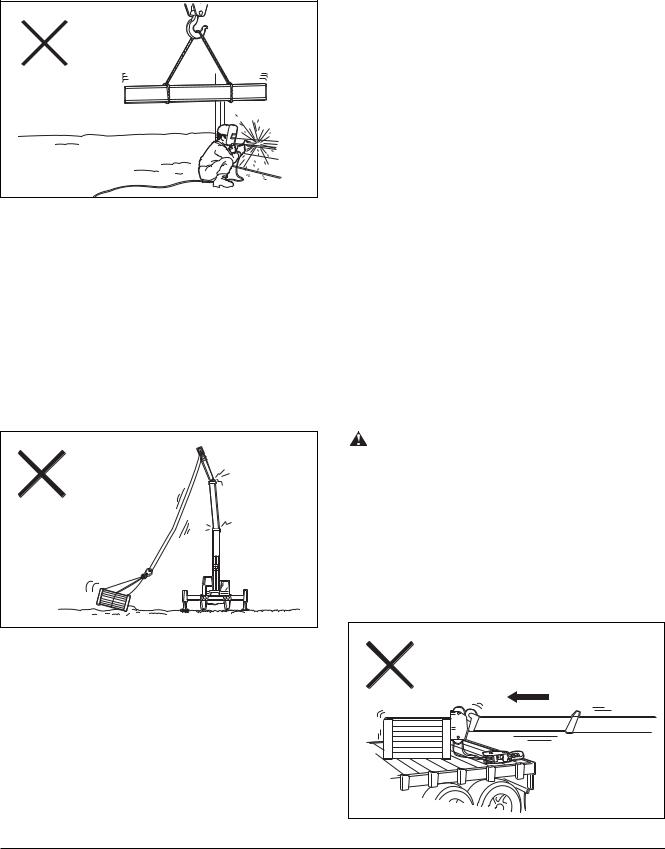
T019605E
 Do Not Pass a Load over Any Person
Do Not Pass a Load over Any Person
Passing a load over a person(s) is very dangerous and must be avoided.
Do not allow anyone to enter the area below the boom or the load.
T00027
 Do Not Pull a Load Sideways, Do Not Lift a Load Obliquely, Do not Drag a Load
Do Not Pull a Load Sideways, Do Not Lift a Load Obliquely, Do not Drag a Load
Pulling a load sideways, lifting a load obliquely or attempting to drag a load is very dangerous. Such actions can damage the boom, jib or swing mechanism, and lead to overturning of the crane.
Do not attempt to draw in a load that is located outside the load radius. To handle such a load, move the crane to the vicinity of the load, and lift it vertically.
 Do Not Leave the Operator’s Cab While a Load Is Suspended
Do Not Leave the Operator’s Cab While a Load Is Suspended
Before leaving the operator’s cab for any reason, be sure to:
•Lower the load to the ground.
•Fully retract the boom and stow it.
•Actuate all brakes.
•Place all control levers in their neutral positions.
•Shut off the engine, and remove the starter key.
•Lock the crane operator’s cab door.
 Never Allow Anyone to Ride on the Machine, Except the Operator
Never Allow Anyone to Ride on the Machine, Except the Operator
If any persons other than the operator (in the operator’s seat) are on the machine, they must be stationed inside the operator’s cab.
 Do Not Allow Anyone to Ride on the Machine
Do Not Allow Anyone to Ride on the Machine
Persons on the machine other than the operator (in the operator’s seat) may fall or be caught by a machine component or other objects. Other persons cause distraction and can disturb the attention and work of the operator.
|
Do Not Push or Pull an Object with the |
|
|
Boom |
|
|
Never use the boom to push or pull an object. Do |
|
|
not use the boom to thrust up an object or force the |
|
|
boom into an object. |
|
|
To move an object, use a machine designed for that |
|
|
purpose, such as a fork lift truck or carryall. |
|
|
Do not use the crane in applications other than |
|
|
those specified. |
|
|
T00017 |
|
|
|
T00016 |
Safety Rules |
A-15 |
Safety Rules |
|
|
|

T019605E
 Caution while Using the Jib (1)
Caution while Using the Jib (1)
Never attempt to lift separate loads on both the boom and jib at the same time, or a single load using both the main and auxiliary winches.
Such practices can damage the boom or jib, or overturn the machine.
T20527 |
 Caution while Using the Jib (2)
Caution while Using the Jib (2)
Lifting a load on the boom with the jib mounted should be avoided, if possible.
If conditions require such a lift, observe the instructions given in the “AML” section of the manual and perform the operation with the utmost care and attention.
 Mount and Stow the Jib Correctly
Mount and Stow the Jib Correctly
Failure to observe the specified procedures for mounting and stowing the jib can damage the jib, or may cause the jib to drop.
Be sure to mount and stow the jib in the correct manner by referring to the “Jib” section in the manual.
T00649
T00013
Safety Rules |
A-16 |
Safety Rules |
|
|
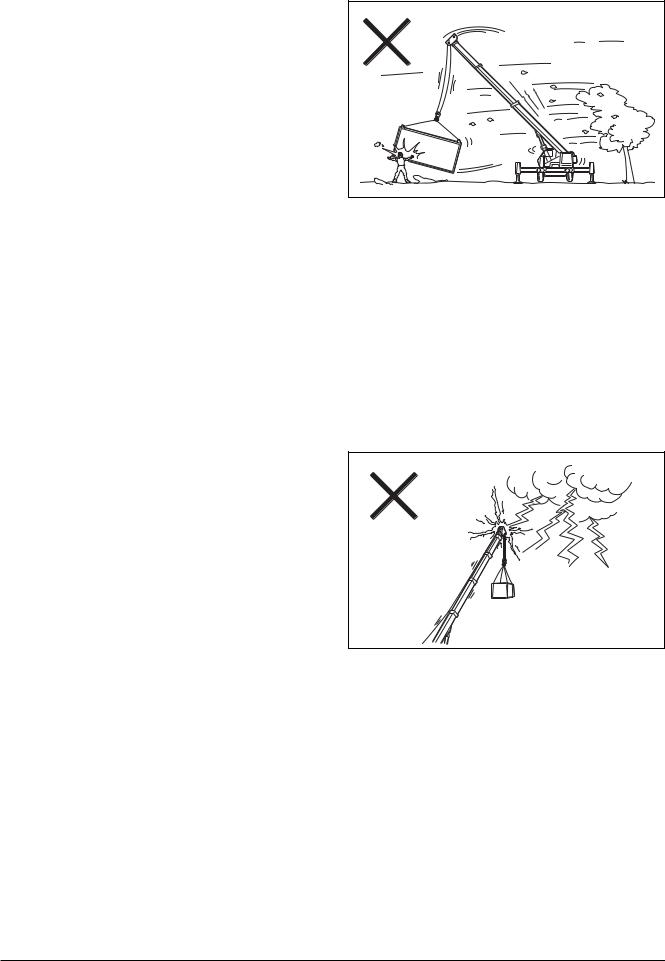
T019605E
Rules for Operation (Weather)
 Stop Operation When Visibility Becomes
Stop Operation When Visibility Becomes
Poor
During bad weather such as rain, snow or fog, stop operation and stow the machine. Wait until visibility improves before resuming operation.
 Stop Operation When Strong Winds are Present
Stop Operation When Strong Winds are Present
Under strong winds, a lifted load will start swaying, posing a danger to working personnel and nearby structures and also possibly damaging the boom or overturning the machine.
The influence of cross wind on machine stability is directly proportional to length of the boom and size of the load.
When the maximum instantaneous (i.e. gust) wind speed exceeds 10 m/sec, stop crane operation and stow the boom.
When the boom is substantially extended or a largesized load is lifted, stop crane operation even if the wind speed is below 10 m/sec if there is any possible danger.
The table below lists wind speed ranges and the ground conditions for each range. Note that the wind speeds in the table are those at a point 10 m above open level ground.
Wind speed (m/sec) |
Ground conditions |
|
5.5– 8.0 |
Dust is raised, paper whirls up, |
|
and small branches sway. |
||
|
||
|
Shrubs with leaves start swaying. |
|
8.0–10.8 |
Wave crests are apparent in |
|
|
ponds or swamps. |
|
|
Tree branches move. Power lines |
|
10.8–13.9 |
whistle. It is difficult to open an |
|
|
umbrella. |
|
13.9–17.2 |
Whole trees sway. It is difficult to |
|
walk against the wind. |
||
|
T00037
 Stop All Operation If There is Any Likelihood of Lightning
Stop All Operation If There is Any Likelihood of Lightning
Lightning can not only damage the machine but also injure the operator and working personnel. If lightning is forecast or expected, stop operation, stow the boom, and leave the machine.
If the machine is struck by lightning:
•Stay in the cab. Do not try to move out.
•Warn people around not to approach the machine.
•Afterward, inspect the entire crane carefully and have any damaged parts repaired.
T00038
Safety Rules |
A-17 |
Safety Rules |
|
|

 Cautions in Cold Weather
Cautions in Cold Weather
•Snow or ice on the crane should be removed before operation; it is especially important to eliminate any accumulation on the boom, as it could fall and injure someone when the boom is moved.
•Do not let bare skin come in contact with the machine’s metallic parts when the temperature is below freezing. Skin can freeze to the metallic surface, if any moisture is present.
•Warm up the machine sufficiently. Then, check that the machine is functioning correctly. Remove ice and dry machine components as required.
•After starting operation, run the machine slowly until oils fully circulates through all machine components.
•Before lifting, make sure that the load is not frozen to the ground or any other objects. Attempting to lift a load which is frozen to the ground can result in severe overloading and is very dangerous.
•If possible, stow the machine indoors so that the tires are not frozen to the ground. Remove mud from the undercarriage.
•Maintain the battery. Use oils and fuel rated for cold weather.
T019605E
Rules for Operation
(Power Lines, Radio Waves)
 Prevent Electric Shock Accidents
Prevent Electric Shock Accidents
Approaching too close to power lines can result in electric shock accidents. If conditions absolutely require operation near power lines or distribution lines, implement the following preventive measures:
•Meet with the power company concerned to develop a relevant safety plan.
•Require that working personnel wear approved insulating shoes.
•Keep the crane and load beyond the required distance (stipulated by national or local laws and regulations) and away from power lines.
•Post a full-time signal person to ensure the machine or load does not approach power lines or unauthorized personnel do not enter the work area.
•Personnel on the ground must not directly touch the machine or load. When necessary to control the lifted load, use dry fiber ropes as tethers to prevent the load from rotating or swaying.
•Do not place a load below or near power lines.
•Operate the crane slowly with the utmost care and attention.
(The data shown below describes the required distance recommended by Japanese power companies.)
Voltage |
|
Required stand-off distance |
||
Low voltage |
100 V, 200 V |
2 meters |
||
High voltage |
6,600 |
V |
||
|
||||
|
22,000 |
V |
3 meters |
|
|
66,000 |
V |
4 meters |
|
Extra high |
154,000 |
V |
5 meters |
|
voltage |
187,000 |
V |
6 meters |
|
|
275,000 |
V |
7 meters |
|
|
500,000 |
V |
11 meters |
|
Should an electric shock accident occur, do not panic. Follow the instructions below:
•Contact the power company to cut off the power and obtain instructions for emergency action.
•Direct all personnel around the machine to evacuate the site. Strictly control the site and keep everyone away from the electrified crane and load.
Safety Rules |
A-18 |
Safety Rules |
|
|
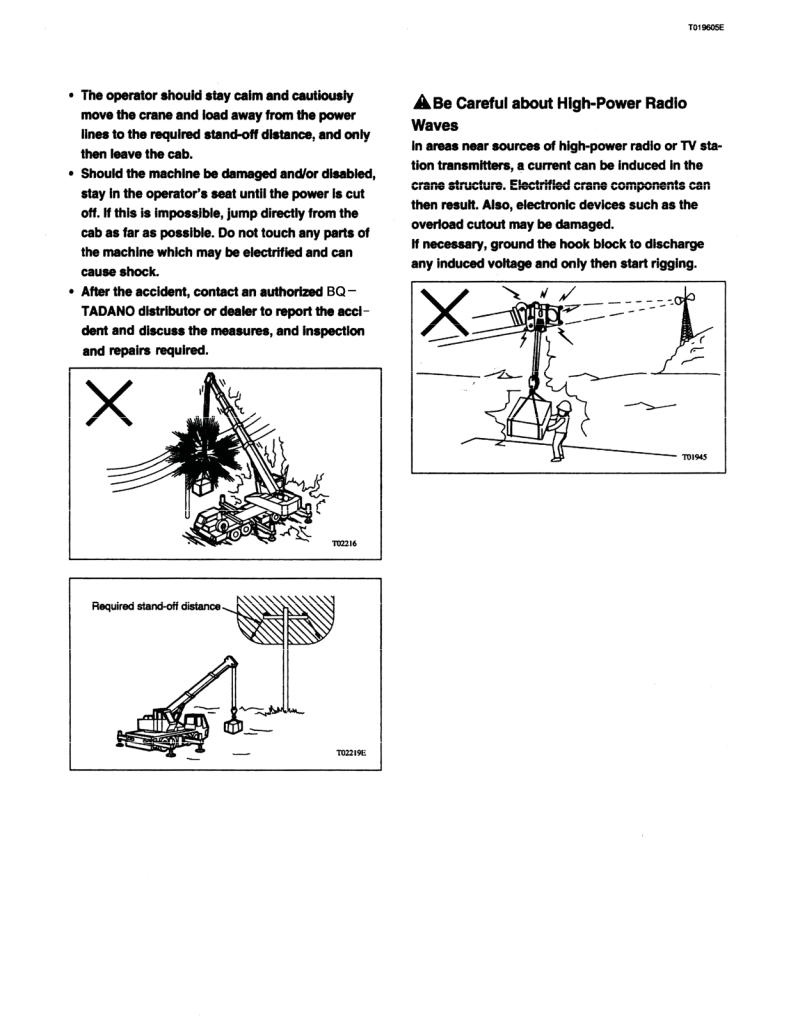
|
|
|
|
|
|
|
|
|
|
Safety Rules |
A-19 |
Safety Rules |
||

T019605E
Rules for Operation
(Special Operation)
 Be Cautious in Multi-Crane Operation
Be Cautious in Multi-Crane Operation
Lifting a load with two or more cranes can be dangerous. In these operations, loads are lifted at points other than directly above the center of gravity and there is possibility of the load falling, the machine being overturned, or the boom failing.
In multi-crane lifting operations, be absolutely careful, and adhere to the following instructions:
•Meet with personnel to determine the proper working procedure and lift strategy.
•Assign a work leader, and follow instructions.
•Equip every person concerned with an appropriate communications device.
•Set each crane level on firm ground with the outriggers fully extended.
•The cranes used must have the same performance, characteristics and sufficient capacity for handling the load. Make sure that the cranes have the same settings for the boom length, boom angle, and number of rope parts.
•Lift the load so that the wire rope(s) of each crane are only subjected to vertical line pulls.
•Attempt to rig the load so that all the cranes are loaded equally.
•To move the load, use only the winches and booms. Swinging operations should be avoided. Do not perform hoisting, elevating (or telescoping) of the boom or swinging at the same time.
•To prevent overloading, operate the separate cranes simultaneously.
T00650 |
After Operation
 After Operation, Stow the Machine
After Operation, Stow the Machine
Leaving the machine unattended should be avoided.
Once operation is complete, stow the machine.
T21496 |
 Cautions for Refilling the Fuel
Cautions for Refilling the Fuel
Fuel and other oils are highly flammable and dangerous.
Handle combustibles very carefully.
While refueling, observe the following instructions:
•Stop the engine.
•Refuel the machine outdoors in a well-ventilated place.
•Keep sources of flames or sparks away from the fuel.
•Wear a protective mask.
•Do not refuel in excess of fuel tank capacity.
A00195
Safety Rules |
A-20 |
Safety Rules |
|
|
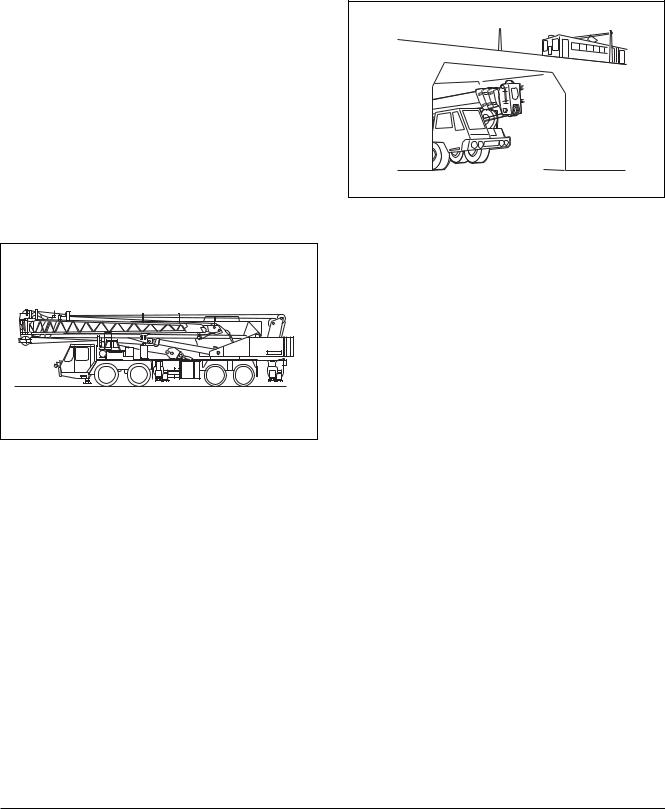
T019605E
Rules for Road Travel
 Observe All Vehicles Code Requirements for Travel on Public Roads
Observe All Vehicles Code Requirements for Travel on Public Roads
Some national and local laws and rules exist regarding the travel of crane vehicles on public roads. Before traveling on roads, study the requirements for road travel for the crane, and strictly obey all the regulations.
 Driving Crane (Carrier) in Road Travel
Driving Crane (Carrier) in Road Travel
Configuration
A swaying hook block or boom, or extended outriggers pose extreme hazards during crane road travel. Before traveling, stow the hook block and boom in position, and lock the outrigger beams, etc., in position (if lock pins are available). Give a traveling configuration to the machine by referring to the manual.
T21496 |
 Do Not Travel with Any Cargo on the Crane
Do Not Travel with Any Cargo on the Crane
Carrying cargo on a traveling crane can result in a spill or fall. Use a vehicle designed specifically for cargo transport.
 Be Aware of Overhead Obstacles
Be Aware of Overhead Obstacles
Pay attention to overhead clearance when passing under electric car wires, highway or railway bridges, and passing through a tunnel.
If the planned route necessitates travel below overhead railway lines or overhead bridges or through a tunnel, check the clearances in advance.
T21495 |
Safety Rules |
A-21 |
Safety Rules |
|
|
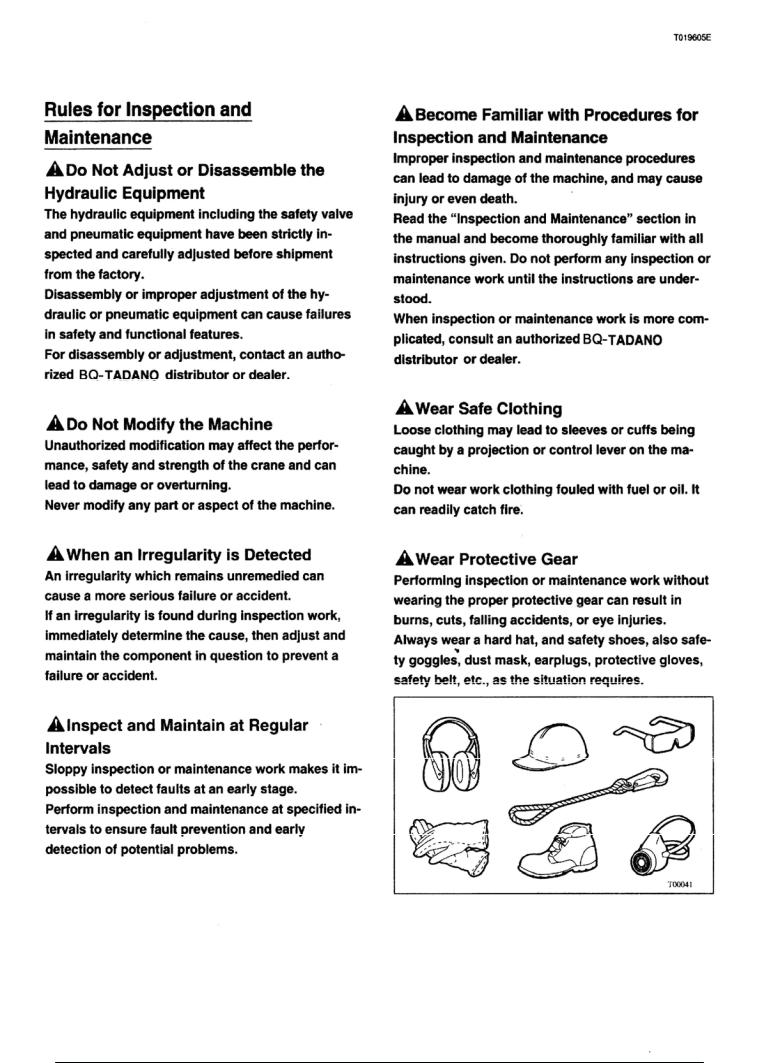
Safety Rules |
A-22 |
Safety Rules |

T019605E
 Meet with Working Personnel
Meet with Working Personnel
Working together with other persons on inspection or maintenance tasks without observing mutually agreed upon procedures can result in an accident. Meet with all involved personnel to agree on the detailed tasks. Also, assign a work leader, and always follow his or her instructions.
 Provide Effective Ventilation
Provide Effective Ventilation
Performing inspection or maintenance work in a confined space without effective ventilation can lead to toxic poisoning.
Be very careful when handling fuel, wash oil, and paint.
When starting the engine in an enclosed space, provide a means of positive ventilation. Connect a hose from the exhaust to vent the fumes outdoors. Open doors and windows to allow fresh air circulation.
Install a ventilator as required.
 Fire Prevention
Fire Prevention
To prevent the risk of fire during inspection and maintenance work requiring handling of potentially flammable substances, observe the following instructions.
•Use a non-flammable cleaning liquid to wash parts and components.
•Store fuel and oils away from fire.
•Do not allow sources of flames or sparks near any substance that is combustible.
•Do not smoke cigar or cigarette.
•Always carry a fire extinguisher in the operator’s cab.
•When checking fuel, oils, and battery liquid, use an explosion-proof lamp.
•When grinding or welding, keep flammable substances away from flying sparks or molten metal.
T01951 |
 About Illumination
About Illumination
Inspection or maintenance work in a poorly illuminated environment can lead to injury. Before starting the work, provide proper illumination. Never use the exposed flame of a match or lighter for illumination, a fire accident may occur. The emitted gas from open lead storage batteries can explode.
Use explosion-preventive type illuminating devices when checking fuel and battery liquid level.
Safety Rules |
A-23 |
Safety Rules |
|
|

 Clean the Machine before Inspection or Maintenance
Clean the Machine before Inspection or Maintenance
Dirt and debris on the machine not only prevents easy detection of faulty components or parts but also can be trapped in components or parts. Also, dust or mud can enter your eyes or cause you to slip and be injured.
Before starting general inspection or maintenance activities, wash the machine to ensure a safe work area.
 Cautions for Washing the Machine
Cautions for Washing the Machine
Wet footing can cause to slip and fall injuries. Always wear non-slip shoes.
When washing the machine with high-pressure steam, the jet can penetrate skin or flying mud can cause eye damage. Always wear suitable protective gear during washing.
Do not direct water to electrical equipment, discharge and/or shortcircuits can result and lead to damage.
 Inspect and Maintain the Machine on Level Ground
Inspect and Maintain the Machine on Level Ground
It is difficult to inspect the machine properly if it is parked on a slope or grade. Also, the machine is liable to start moving if not parked properly.
Park the crane on firm flat ground, activate the parking brake, and chock the tires.
 Keep the Work Area Clean and Tidy
Keep the Work Area Clean and Tidy
Performing inspection or maintenance work in a disorderly place can lead to personal injury or a falling accident.
Remove obstacles.
T019605E
 Labeling for Inspection or
Labeling for Inspection or
Maintenance Work
If any unauthorized person starts the engine during inspection or maintenance work, the machine may be damaged or injury or even death may result.
When performing inspection or maintenance work, remove the starter key, and post a “DO NOT OPERATE” or “TAG OUT” sign on the door or control levers of the operator’s cab as a warning.
Also, post relevant warning signs at entry to the work area to prevent access of unauthorized personnel.
 Start Inspection or Maintenance after the Machine Has Cooled Down
Start Inspection or Maintenance after the Machine Has Cooled Down
When the crane is operated, various machine components become very hot and can cause burns. These components include the engine, muffler, engine cooling water, radiator, hydraulic oil, reducer, hydraulic equipment and hydraulic piping.
Allow these components and areas to cool down before starting inspection or maintenance work.
 Beware of High-Pressure Oils
Beware of High-Pressure Oils
High-pressure fuel or hydraulic oil that comes into contact with skin or eyes can cause serious injury. To avoid this danger:
•Release internal pressure, and only then, disconnect any piping.
•To check for leakage, wear protective goggles and gloves and use a piece of cardboard or wood as a monitor. Leaking high-pressure oil may be invisible.
Keep bare hands away from all leaking components.
•Immediately obtain medical attention when highpressure oil accidentally cuts into skin or affects the eyes.
Safety Rules |
A-24 |
Safety Rules |
|
|

T019605E
 Inspect or Maintain Equipment with the Engine Shut Down
Inspect or Maintain Equipment with the Engine Shut Down
Performing inspection or maintenance work while the engine is running is very dangerous, and should be avoided. Unless otherwise necessary, be sure to shut down the engine before starting inspection or maintenance procedures.
 Use Two Persons for Inspection or Maintenance with the Engine Running
Use Two Persons for Inspection or Maintenance with the Engine Running
If for some reason it is necessary to perform an inspection or maintenance procedure with the engine running, post at least two persons—one in the operator’s cab to shut down the engine immediately when necessary, and the other(s) to perform maintenance. During the maintenance, ensure safety of all persons involved in the work.
 Use Proper Tools
Use Proper Tools
Performing inspection or maintenance work without the proper tools not only decreases work efficiency but also can lead to damage to parts or even injury. Do not use improper or damaged tools.
 Beware of Overhead Obstacles and
Beware of Overhead Obstacles and
Footing
Lack of awareness or loose footing can cause head impact with the hook block, boom, or jib or slip and falls off the machine.
Always be careful about overhead obstacles and footing. Walk on the non-slip strips if provided on the machine.
 Cautions for Working at Heights
Cautions for Working at Heights
Working at heights involves the possibility of falling. To reduce this risk, remove all obstacles, and any spilled grease and oil. Keep all footing areas clean and tidy.
To climb onto and descend from a position of high elevation, face the machine directly. Use the handrails and steps, always be supported by at least three points of your hands and feet.
Be careful not to slip. When non-slip strips are provided on the machine, walk on them.
Use safety equipment such as safety belts ties, lanyards and platforms as the situation requires.
 Cautions for Working Under the Machine
Cautions for Working Under the Machine
When working under the crane with the jack cylinders extended, place supports and wood blocks beneath the outriggers to support the machine securely. Do not work under the crane unless the machine is securely and positively supported.
 Do Not Stick Any Part of Your Body Out from the Window on the Boom Side
Do Not Stick Any Part of Your Body Out from the Window on the Boom Side
Sticking any part of your body out from the window on the boom side can result in being caught between the moving boom and the window frame. Serious injury or death can result from this dangerous practice.
If the window is equipped with a confining guard, do not remove it.
T03835 |
Safety Rules |
A-25 |
Safety Rules |
|
|

 Keep Away from Moving Parts
Keep Away from Moving Parts
Inadvertent motion of the machine, or contacting a moving part can cause personal injury and even death.
When necessary to inspect or maintain the machine while running, do not approach moving parts such as the boom, elevating cylinder, winch, fan, fan belt, and propeller shaft, etc.
Keep hands and clothing away from moving parts.
T019605E
 Do Not Allow Tools and Parts to Drop
Do Not Allow Tools and Parts to Drop
When working through an inspection hole while facing down, be careful not to drop objects into the hole. Such mistakes can damage or lead to malfunction of the machine. Do not keep objects which are not needed for inspection in open pockets.
Recover any object or tool that has dropped into the machine.
T00046
 Beware of an Overheated Cooling
Beware of an Overheated Cooling
System
Do not unfasten the radiator cap while the engine cooling water is hot. Hot steam and water can spurt out, causing burns.
First allow the radiator to cool down. Then, loosen the cap very slowly while facing away to release the internal pressure.
T00044 |
 Lock the Inspection Hole Covers
Lock the Inspection Hole Covers
An inspection hole cover that remains open can be closed abruptly by a gust, etc., causing hands or a leg to be caught and injured.
If an inspection hole cover or access door, or the operator’s cab door must remain open, secure in position.
 Beware of Oil Smears
Beware of Oil Smears
Oil smears on the clutch, lining and brake disks can decrease braking effectiveness. Always keep these assemblies free from oil accumulation.
 Beware of Dust
Beware of Dust
Be careful not to inhale dust during inspection or maintenance work. To inspect or maintain brakes and linings, remove dust using a vacuum cleaner.
Do not use compressed air because this action will scatter dust into the air.
Safety Rules |
A-26 |
Safety Rules |
|
|
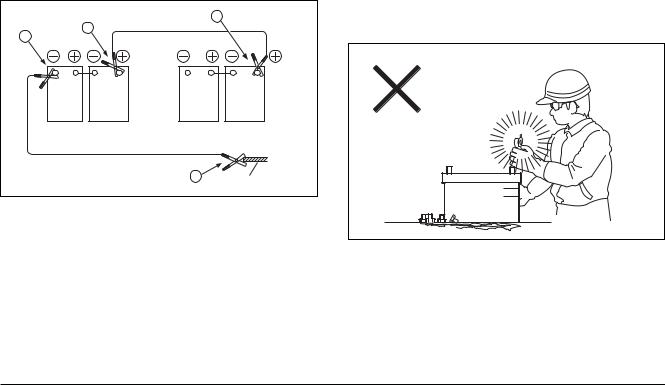
T019605E
 About Starting the Engine with Booster Cables
About Starting the Engine with Booster Cables
Using improper booster cables to start the engine can cause the battery to explode or damage the machine.
When starting the engine using booster cables, wear protective goggles. This procedure requires two persons; one person must be seated in the operator’s cab. The procedure consists of:
(1)Use an assist vehicle with a battery rated for 24 V. Do not use a 12 V or 48 V supply.
(2)Set the starter key to “OFF” position both for the dead vehicle and assist vehicle.
(3)Connect the booster cables in the following order:
[1] “+” terminal of the battery on the dead vehicle.
[2] “+” terminal of the battery on the assist vehicle.
[3] “-” terminal of the battery on the assist vehicle.
[4] A portion of the frame or engine block of the dead vehicle, apart from its battery.
(4)Start the engine of the assist vehicle.
(5)Start the engine of the dead vehicle.
(6)Once the engine of the dead vehicle has successfully started, disconnect the booster cables in the order of [4], [3], [2] and [1].
Booster cable |
1 |
|
2 |
|
|
3 |
|
|
Service vehicle battery |
Disabled vehicle battery |
|
Booster cable |
|
|
|
4 |
Frame |
|
|
T21796E |
 Disconnect the Battery Cable before Inspecting or Maintaining the Electrical System
Disconnect the Battery Cable before Inspecting or Maintaining the Electrical System
Inspecting or maintaining the electrical system without disconnecting the battery cable can cause the wiring to be shortcircuited, possibly damaging the electrical and electronic systems.
Before inspecting or maintaining the electrical system, disconnect the battery cable from the minus terminal (ground side) of the battery.
 Be Cautious about Battery Fluid
Be Cautious about Battery Fluid
The battery fluid contains dilute sulfuric acid. Battery fluid entering the eyes could cause blindness, and battery fluid on skin can cause burns. When handling the battery, wear protective goggles, protective gloves, and long-sleeved clothing.
If battery fluid touches your eyes or skin, wash with a large amount of fresh water and seek medical attention immediately.
 Prevent Explosion of the Battery
Prevent Explosion of the Battery
The battery releases hydrogen gas. Do not light a match or lighter near the battery.
To check the battery fluid level, use a flash light.
If battery fluid is frozen in extreme freezing weather, do not charge the battery or start the engine with an alternative power supply.
Warm up the battery to 15°C so to avoid trouble.
H
L
T00043
 Careful Handling of Wire Ropes
Careful Handling of Wire Ropes
Careless handling of wire ropes can shorten their service life, or cause them to break. Handle wire ropes properly by observing all instructions in the manual.
Safety Rules |
A-27 |
Safety Rules |
|
|

Safety Rules |
A-28 |
Safety Rules |

|
|
|
|
|
|
|
|
|
|
|
|
|
|
|
|
|
|
|
|
|
|
|
|
|
|
|
|
|
|
Warning Labels |
A-29 |
Warning Labels |
||
